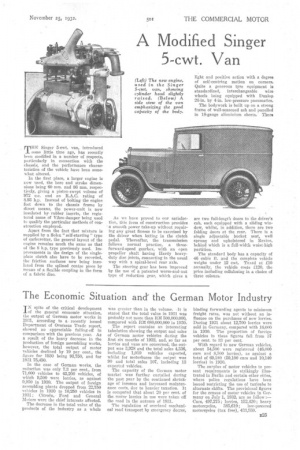The Economic Situation and the German Motor Industry
Page 43

If you've noticed an error in this article please click here to report it so we can fix it.
IN spite of the critical development of the general economic situation, the output of German motor works in 1931, according to arecently issued Department of Overseas Trade report, showed no appreciable falling-off in comparison with the previous year. As a result of the heavy decrease in the production of foreign assembling works, however, the total output of motor vehicles declined by 19 per cant., the figure for 1930 being 93,750, and for 1931 75,450.
In the case of German works, the reduction was only 7.3 per cent., from 71,000 vehicles to 65,200 vehicles, of which 9,500 were lorries, as against 9,950 in 1920. The output of foreign assembling plants dropped from 22,750 vehicles in 1930 to 10,250 vehicles in 1931; Citron,Ford and General Motors were the chief interests affected.
The decrease in the total valise of the products of the industry as a whole was greater than in the volume. -It is stated that the total value in 1931 was probably not more than Rhel 500,000,000, compared with RAI 680,000,000 in 1930.
The report contains an interesting tabulation showing the output and sales of German motor vehicles during the first six months of 1932, and, so far as lorries and vans are concerned, the output was 3,928 and the total sales 4,336, including 1,019 vehicles exported, whilst for motorbuses the output was 90 and total sales 107, including 13 exported vehicles.
The capacity of the German motor market was further curtailed during the past year by the continued shrinkage of incomes and increased maintenance costs, due to heavier taxation. It is computed that about 20 per cent of the motor lorries in use were taken off the road in the autumn of 1931.
The regulation of overland mechanical road transport by emergency decree, binding forwarding agents to minimum freight rates, was not without an influence on the purchases of new lorries. During 1931 about 12,700 lorries were sold in Germany, compared with 16,000 in 1930. The proportion of foreign vehicles in these figures fell from 37 per cent. to 33 per cent With regard to new German vehicles, about 54,500 were registered (46,000 cars and 8,500 lorries), as against a total of 69,240 (59,100 cars and 10,140 lorries) in 1930.
The surplus of motor vehicles to present requirements is strikingly illustrated in Berlin and certain other cities, where police regulations have been Issued restricting the use a taxicabs to alternate shifts. The provisional figures for the census of motor vehicles in Germany on July 1, 1932, are as follow :— Cars, 49'7,275; lorries, 152,420; heavy motorcycles, 385,619; low-powered motorcycles (tax free), 438,559.




































































































